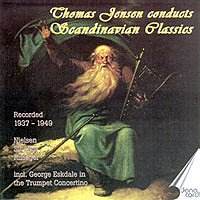




Johan Peter Emilius HARTMANN (1805-1900)
Thrymskviden: Triumphal March of the Nordic Gods (1)
Niels GADE (1817-1890)
Echoes of Ossian, op. 1 (2)
Johan SVENDSEN (1840-1911)
Romance, op. 26 (3)
Fini HENRIQUES (1867-1940)
Voelund the Smith: Prelude (4)
Peter Erasmus LANGE-MÜLLER (1850-1926)
Renaissance: Prelude (5)
Carl NIELSEN (1865-1931)
Little Suite for Strings, op. 1 (6), Helios, overture, op. 17 (7), The Mother: March (8), Saul and David: Act 2 Prelude (9)
Jan SIBELIUS (1865-1957)
Finlandia, op. 26 (10), Valse triste, op. 44/1 (11), Valse lyrique, op. 98a (12)
Finn HØFFDING (1899-1997)
"It is perfectly true" – Symphonic Fantasy after Andersen (13)
Svend Erik TARP (1908-1994)
Mosaik – Miniature Suite (14)
Knudåge RIISAGER (1897-1974)
Little Overture for Strings (15), Concertino for Trumpet and Strings (16), Twelve by the Mail-coach, Ballet: January, May, August, October (17), Paradise of Fools – Suite (18), Two Beggar-pupils’ Songs (19), On the Occasion of – (20)
Carlo Andersen (violin) (3), George Eskdale (trumpet) (16), Copenhagen Philharmonic Orchestra (1, 2, 3, 18, 19, 20), Danish State Radio Orchestra (15, 16), Royal [Danish] Orchestra (6, 7, 8), Tivoli Concert Hall Orchestra (4, 5, 9, 10, 11, 12, 13, 14, 17)/Thomas Jensen
Recorded in Copenhagen, 8th September 1937 (18), 7th July 1938 (19, 20), August 31st 1939 (3), January 31st & February 22nd 1941 (6), Summer 1942 (1, 2, 7, 8), July 2nd 1942 (9, 10), 7th-8th September 1942 (5), 7th & 9th September 1942 (14), 24th-25th January 1945 (17), 23rd June 1947 (11, 13), 4th September 1947 (12), 7th September 1948 (4), 27th-28th January 1949 (15, 16)
AVAILABILITY